|
|
|
Sort Order |
|
|
|
Items / Page
|
|
|
|
|
|
|
| Srl | Item |
| 1 |
ID:
162789
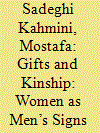

|
|
|
|
|
| Summary/Abstract |
This essay investigates the Iranian film ʿArus-e Ātash, directed by Khosrow Sināʾi in 1999, through the lens of gender studies. In doing so, it employs Claude Lévi-Strauss’ theory of kinship and elementary structures in order to create a context for the social structure of ʿashira as the prevailing unit of society among Khuzestāni Arabs of Iran. The significance of gift exchange as the predominant form of making alliances, as well as the position of women as the nucleus of these exchanges, is further discussed to shed light on the different socialization of male and female individuals in the ʿashira. Using Lévi-Strauss’ ideas in conjunction with the gender feminism of Kate Millett and Catharine A. MacKinnon, the study explores how women in primitive societies have the dual function of being the men’s property on an objective level as well as the means for alliance-making on a subjective one—a sign and a value at the same time. The essay concludes that men can also be considered as the victims of the patriarchal system since it creates a cultural image of men imbued with excessive masculinity that they may not be able live up to.
|
|
|
|
|
|
|
|
|
|
|
|
|
|
|
|
| 2 |
ID:
120856
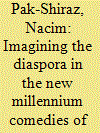

|
|
|
|
|
| Publication |
2013.
|
| Summary/Abstract |
This article examines the genre of comedy in Iranian cinema and explores the various influences on its development and growth. It demonstrates how the roots of recent comedies can be traced back to pre-Revolution commercial cinema (known as filmfarsi) as well as the traditional Iranian comic theatre of taqlid. In particular, it focuses on the depictions of the Iranian diaspora in these comedies. The Iranian diaspora has been imagined and represented frequently in modern Persian culture, often satirically and humorously. More recently, Iranian comedies have provided a new space to imagine, define, criticize and redeem the Iranian diaspora.
|
|
|
|
|
|
|
|
|
|
|
|
|
|
|
|
| 3 |
ID:
095103
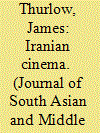

|
|
|
| 4 |
ID:
104277
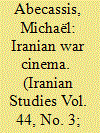

|
|
|
|
|
| Publication |
2011.
|
| Summary/Abstract |
The fascination for the Western world with Iranian cinema lies primarily with the fablelike
developments of its stories which often plunge us into a world of exoticism and lured us
with its singularity. Iranian war cinema born during the war between Iran and Iraq is not
as well distributed in Europe and films with English subtitles are difficult to get hold of.
Whether it is interpreted as an anthropological document which opens a dialogue between
the protagonist and the spectators, the "I" and the other, Iranian war cinema by Tabrizi,
Sinayi, Hatamikia and Ghobadi, among many others, can be seen as a spiritual voyage
where the soul hovers between absence and presence. In the wake of war cinema in
general, one can draw parallels with mythology, the Judeo-Christian tradition,
literature and art. Its function is not only didactic but cathartic, and the particularity
of Iranian war cinema like no other is that it participates in the mourning process of a
whole nation fighting against its own ghosts and in search of its identity. This article
attempts to decipher the myths hidden behind the images presented by Iranian war
cinema, paradoxically interweaving the traumatic with the aesthetic.
|
|
|
|
|
|
|
|
|
|
|
|
|
|
|
|
| 5 |
ID:
155086
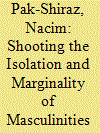

|
|
|
|
|
| Summary/Abstract |
This article examines the isolation and marginality of Iranian men living in contemporary Iran with a focus on three post-2005 films. As a patriarchal society, Iran has been the subject of many studies on the subjugation and marginality of women. This study demonstrates how recent Iranian films have skillfully employed the cinematic language to narrate men’s stories of alienation and despair. These filmic constructions provide a valuable and complex insight into masculine identities, challenging perceptions of the essentialized image of the Middle Eastern male. By employing Connell’s hierarchy of masculinities, the article demonstrates the position of marginalized men in relation to the dominant ideals of masculinity and the influence of these discourses on the lives of such men. The films discussed here do not perpetuate the construction of the ‘true’ gender, but instead challenge ideas of heroism, manliness and patriarchy.
|
|
|
|
|
|
|
|
|
|
|
|
|
|
|
|
| 6 |
ID:
124470
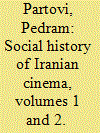

|
|
|
|
|
| Publication |
2013.
|
| Summary/Abstract |
Hamid Naficy has finally rewarded readers with his long-planned and eagerly anticipated multi-volume history of Iranian cinema. The first two volumes reviewed here, covering the late Qajar and Pahlavi eras (1897-1978), were first published in September 2011. The third volume, subtitled "The Islamicate Period, 1978-1984," reached press in late spring 2012. The fourth and final volume, on "The Globalizing Period, 1984-2010," was published in November 2012. The sheer size of Naficy's undertaking signals its importance to the field and to the author. It is in many ways a life's work. In fact, the biographical preface to the first volume describes a lifelong engagement with cinema that has informed this project. Naficy presents the end product as the culmination of nearly four decades of research and writing. But his personal investment in the work is not the sole justification for it. Within its pages, Naficy forcefully makes a case for cinema's centrality to Iranian life-its images, voices, and ideas pushing and pulling a society in transition towards and away from modernity.
|
|
|
|
|
|
|
|
|
|
|
|
|
|
|
|
| 7 |
ID:
177055
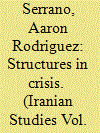

|
|
|
|
|
| Summary/Abstract |
This paper proposes an exploration of the films of Iranian director Asghar Farhadi. It employs a methodology based on textual analysis, focusing specifically on the structural design of his films and the focalization processes of his scripts. It shows how Farhadi’s work can be understood as a coherent research project with a uniquely solid model based on chronological linearity as a way to explore the violent breakdown of different emotional communities: families, marriages, groups of friends, etc. At the same time, it considers how all the focalization processes in his films are oriented toward two main concepts: knowledge (of the characters, but also of the audience) and pain (of living in a [narrative] world afflicted by meaninglessness).
|
|
|
|
|
|
|
|
|
|
|
|
|
|
|
|
|
|
|
|
|